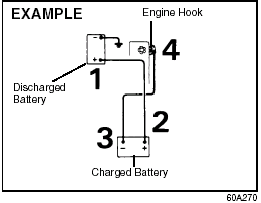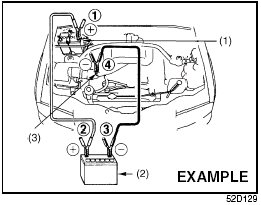Suzuki Grand Vitara: Jump Starting Instructions
 WARNING:
WARNING:
• Never attempt to jump start your vehicle if the battery appears to be frozen.
Batteries in this condition may explode or rupture if jump starting is attempted.
• When making jumper cable connections, be certain that your hands and the jumper
cables remain clear from pulleys, belts or fans.
• Batteries produce flammable hydrogen gas. Keep flames and sparks away from the
battery or an explosion may occur. Never smoke when working near the battery.
• If the booster battery you use for jump starting is installed in another vehicle,
make sure the two vehicles are not touching each other.
• If your battery discharges repeatedly, for no apparent reason, have your vehicle
inspected by an authorized SUZUKI dealer.
• To avoid harm to yourself or damage to your vehicle or battery, follow the jump
starting instructions below precisely and in order. If you are in doubt, call for
qualified road service.
CAUTION: Your vehicle should not be started by pushing or towing. This starting method could result in permanent damage to the catalytic converter. Use jumper cables to start a vehicle with a weak or run-down battery.
When jump starting your vehicle, use the following procedure:

1) Use only a 12 volt battery to jump start your vehicle. Position the good 12V battery close to your vehicle so that the jumper cables will reach both batteries. When using a battery installed on another vehicle, DO NOT LET THE VEHICLES TOUCH. Set the parking brakes fully on both vehicles. 2) Turn off all vehicle accessories, except those necessary for safety reasons (for example, headlights or hazard lights).


3) Make jumper cable connections as follows: 1. Connect one end of the first jumper cable to the positive (+) terminal of the discharged battery (1). 2. Connect the other end to the positive (+) terminal of the booster battery (2). 3. Connect one end of the second jumper cable to the negative (–) terminal of the booster battery (2). 4. Make the final connection to an unpainted, heavy metal part (i.e. engine hook (3)) of the engine of the vehicle with the discharged battery (1).
 WARNING: Never connect the jumper
cable directly to the negative (–) terminal of the discharged battery, or an explosion
may occur.
WARNING: Never connect the jumper
cable directly to the negative (–) terminal of the discharged battery, or an explosion
may occur.
4) If the booster battery you are using is installed on another vehicle, start the engine of the vehicle with the booster battery. Run the engine at moderate speed. 5) Start the engine of the vehicle with the discharged battery. 6) Remove the jumper cables in the exact reverse order in which you connected them.
Towing a Disabled Vehicle
Emergency Towing
If your vehicle is disabled, it may be towed by a tow truck using one of the following methods: 1) Tow the vehicle with two wheels lifted by the tow truck and the other two wheels on a towing dolly. 2) Use the appropriate towing method specified for your vehicle in the “Towing Your Vehicle (recreational towing)” section, but with the wheels lifted by the tow truck instead of on a towing dolly. Be sure to carefully follow the specific instructions provided in the “Towing Your Vehicle (recreational towing)” section.
CAUTION: If vehicle damage (such as steering or drivetrain damage, inability to operate free axle mechanism, etc.) prevent normal use of the towing procedures for your vehicle described in the “Towing Your Vehicle (recreational towing)” section, have your vehicle towed with two wheels lifted by the tow truck and the other two wheels on a towing dolly.
If the Starter Does Not Operate
1) Try turning the ignition switch to the “START” position with the headlights turned on to determine the battery condition. If the headlights go excessively dim or go off, it usually means that either the battery has run down or battery terminal contact is poor. Recharge the battery or correct battery terminal contact if necessary. 2) If the headlights remain bright, check the fuses. If the reason for failure of the starter is not obvious, there may be a major electrical problem. Have the vehicle inspected by your authorized SUZUKI dealer.
If the Engine is Flooded
If the engine is flooded with gasoline, it may be hard to start. If this happens, press the accelerator pedal all the way to the floor and hold it there while cranking the engine. (Do not operate the starter motor for more than 15 seconds).
See also:
Rear differential gear oil
There is no rear differential gear oil level
gauge. To check the rear differential gear
oil level, consult your SUBARU dealer for
inspection. ...
Towing
If your vehicle needs to be towed
If you need to tow your vehicle, we recommend that you contact a MITSUBISHI MOTORS
Authorised Service Point or tow truck company. In the following cases, transport
the vehicle using a tow truck.
● The ...

 Jacking Instructions
Jacking Instructions